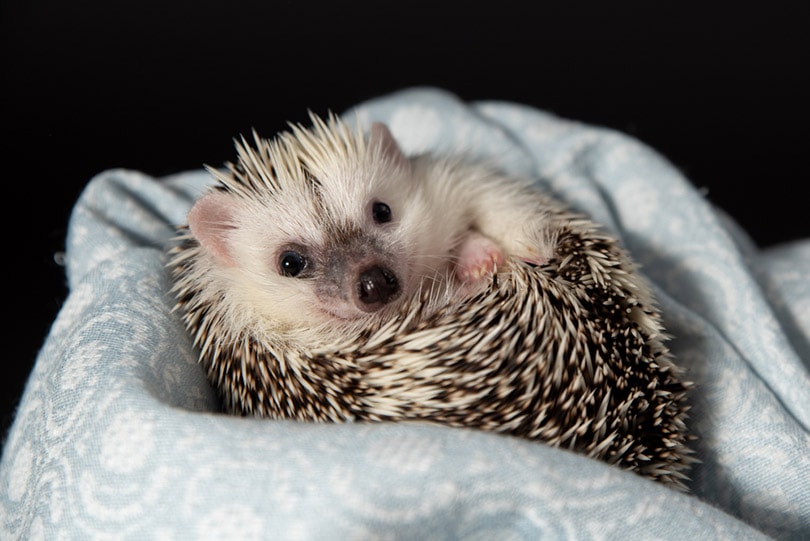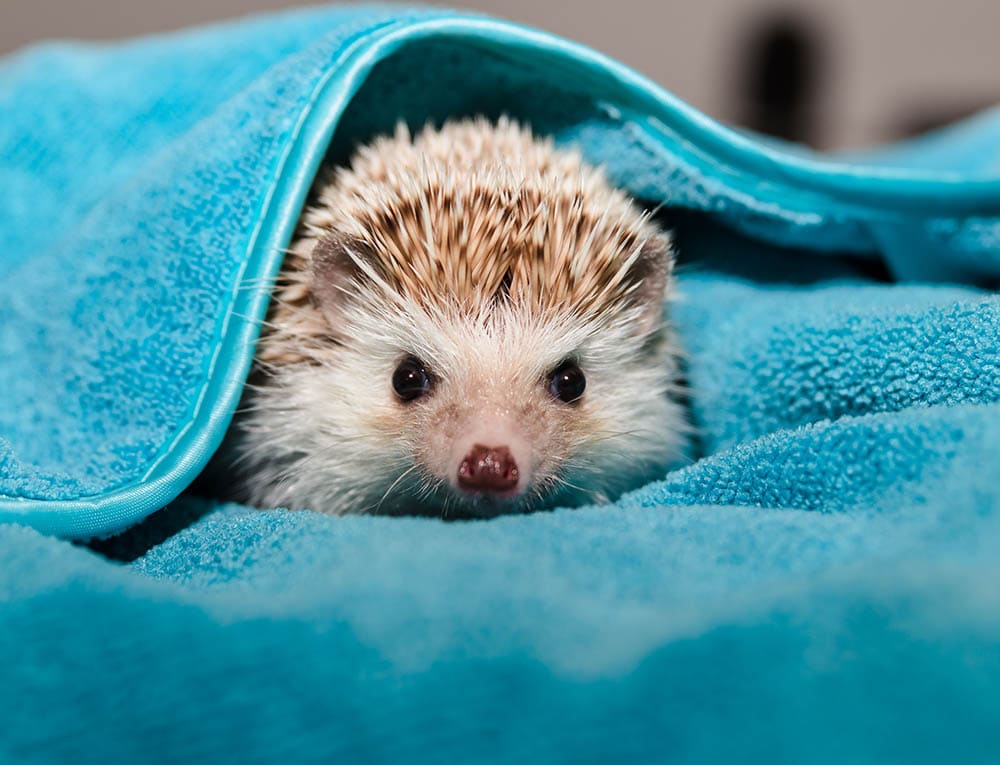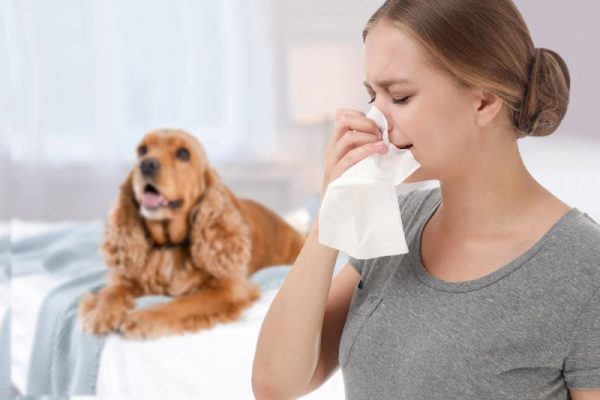Hedgehogs and dogs: These are two different species that seem quite opposite to each other. One is soft and the other is spiny; one is tiny and the other is large (usually); one sleeps all night and the other sleeps all day. So, is it at all possible for a dog and hedgehog to get along?
There isn’t a solid answer here, as it depends on the dog and how well both species have been socialized. But it is technically possible, although both species can live in the same home without the need to ever interact or meet one another, in order to avoid any unnecessary injuries and stress.
Keep in mind that many reputable veterinary organizations worldwide discourage keeping African Pygmy hedgehogs as pets, as they have a need for foraging and roaming large distances, which cannot be fulfilled in a home environment, significantly impacting the animal’s health and welfare.1
Here, we discuss tips for keeping both your pets safe.
 Hedgehog Temperament and Behavior
Hedgehog Temperament and Behavior
The African Pygmy hedgehog is the most common and popular domesticated breed. It’s also known as the four-toed hedgehog and is typically between 7 and 9 inches long.2 These solitary and quiet animals don’t generally seek out people or other pets for companionship.
They are nocturnal and are more active at night, so they might be up and ready for action at dinnertime and ready for bed when you’re getting up in the morning. They don’t tend to bite because they are covered in quills, which is their best defense.
Temperament depends on the individual hedgie, but most show no desire to interact with people or other animals besides their own species. They are curious and intelligent animals and may enjoy zipping around your place when it’s quiet and undisturbed. It’s thought that the females might be more social than the males.

Dog Temperament and Behavior
It’s tougher to pinpoint a dog’s behavior and temperament because there are so many breeds and variables for each individual.
If your dog is social and friendly and tends to make friends quite easily with everyone and everything, chances are that making friends with a hedgehog won’t be much of a problem. Regardless of how sweet your dog is, though, it’s not necessary for either of the species to meet one another, as they are unlikely to benefit in any way from this interaction. They can both live a healthy and fulfilled life without even knowing the other one lives in the same home, as long as the hedgehog’s housing and welfare needs are met, which is challenging in captivity.
If however, you decide to go ahead with introducing the two pets, introductions should still be slow and careful. This is more likely to work if your dog has a calm, easygoing, and laidback temperament, as they might not really care about the hedgehog.
However, if your dog has a high prey drive and tends to chase after smaller animals, like squirrels, this will not be a good match. Many hound dogs and terriers were bred to chase down and eliminate small animals, so bear this in mind.
Signs of a Stressed Hedgehog
It’s usually obvious when dogs are stressed or upset, but since hedgies are still comparatively new as domestic pets, we are not as familiar with the signs of a stressed hedgehog.
First, it does take time for a hedgehog to become used to being handled. Second, you need to get into the habit of washing your hands before and after handling your hedgie.
Signs of a stressed hedgie are:
- Hiding and refusing to come out
- Not grooming or overgrooming
- Less activity
- Loss of appetite
- Pacing and yawning
- Sleeping or tired in the evenings (which is when it should be most active)
- Motionless or freezing up when you are close by
- Aggressiveness
- Fur and spikes falling out
- Attempting to escape when being handled
- Shaking of the head and twitching nervously
- Jumping, hissing, and snorting
When a hedgehog is truly frightened, it will tuck in its legs, head, and tail into its belly and form a spiky ball. This is full-on hedgie protection mode.

Introducing the Dog and Hedgehog
As we already mentioned, there is no real benefit in introducing the two pets, and more likely this will cause stress in the hedgehog. Some dogs may try to pick the hedgehog up, which can lead to injuries for both pets. The dog and hedgehog can live happy and healthy lives in the oblivion of one another’s existence, as long as their needs are met.
Knowing all of this, if you still want to proceed with introducing the two pets, safety is the first and most crucial part of the process. You should also be aware that since hedgehogs are solitary animals, they are unlikely to form a friendship or want to hang out with a dog.
Before introducing your hedgie to your dog, they must be comfortable with you first. You must work on forming a bond with your hedgehog so it will be at ease with you before the big introduction. It would also help if you had another person to help you with this process, as they can help restrain your dog if necessary.
Start by holding your hedgehog when you first introduce them to your dog for their initial meetings. These interactions should occur when your dog is calm and receptive. Of course, your pup will be curious, and due to the hedgehog’s natural defense of sharp quills, your dog will learn quickly about treating it with respect.
Try tiring out your dog before the introduction; go for a long walk or throw a ball around for a while. If your dog has less energy, that reduces the chance of them wanting to use your hedgie like a toy.
The moment that your dog starts to become overeager and hyper or your hedgie seems stressed, the meeting is done.
Warnings
First, if your dog is usually hyper and particularly boisterous, you’ll want to supervise all interactions between the two, even when your pup is calm. While most dogs might be careful about touching a hedgehog because of the quills, if your dog is large and excitable, the quills might not matter. A hedgehog and a dog alike could be injured during rough play.
In general, if you know that your dog has a high prey drive or that they’re rough during playtime, you should either avoid having any other, smaller animals around or keep them completely separate. It’s usually best to not have smaller pets with high prey-drive pups.
If your hedgie never seems entirely at ease around your pet, particularly if it always curls into a ball or exhibits clear signs of stress in their presence, you’ll need to avoid trying to establish any further contact between them going forward and prioritize your hedgehog’s welfare and safety. Your dog shouldn’t bother your hedgehog, whether it’s inside or outside of its cage.
Finally, if your dog is the one terrified by your hedgie, this is another reason to keep them apart. You don’t want to cause your dog any undue stress.

Socialization Is Key
If your pets are comfortable spending time in the same room, ideally ignoring each other and doing their own thing, pick a small room to allow them to safely become used to each other. Be sure to keep an eye on them both and keep the dog on the leash.
In the beginning stages, you’ll want to only allow a few minutes of interaction each day so they’ll slowly become familiar with each other, but make sure the dog’s movement is restricted and that the hedgehog has a place to retreat and hide if they choose to do so. If you do this consistently and limit their time together, it will go a long way toward socializing them both.
This is key for your hedgie because long periods of time spent socializing might be too stressful.

Final Thoughts
Bringing a dog and hedgehog together can be hit or miss, and is generally not required, beneficial for either of the two pets, nor is it recommended. If you still want to try and make the introductions knowing the possible risks, it may come down to your dog’s and hedgie’s personalities and temperaments. Remember that slow and steady wins the race. Try to bring in someone to help, so you can hold your hedgie, and they can hold your dog for the first few meetings.
Keep socialization times short, and always keep an eye on them both. Your hedgehog is quite capable of injuring your dog, almost as much as your dog can potentially injure your hedgie.
If you are only thinking about getting a hedgehog, do your research first. Their welfare needs are quite specific and are not easy to be fulfilled in captivity, significantly impacting their quality of life. If you’re already an experienced owner, socializing your hedgie with any pets that you have is generally not required and will not benefit your hedgehog, while it may cause them stress or worse.
See also:
Featured Image Credit: Szilvia Pap – Kutasi, Shutterstock

















